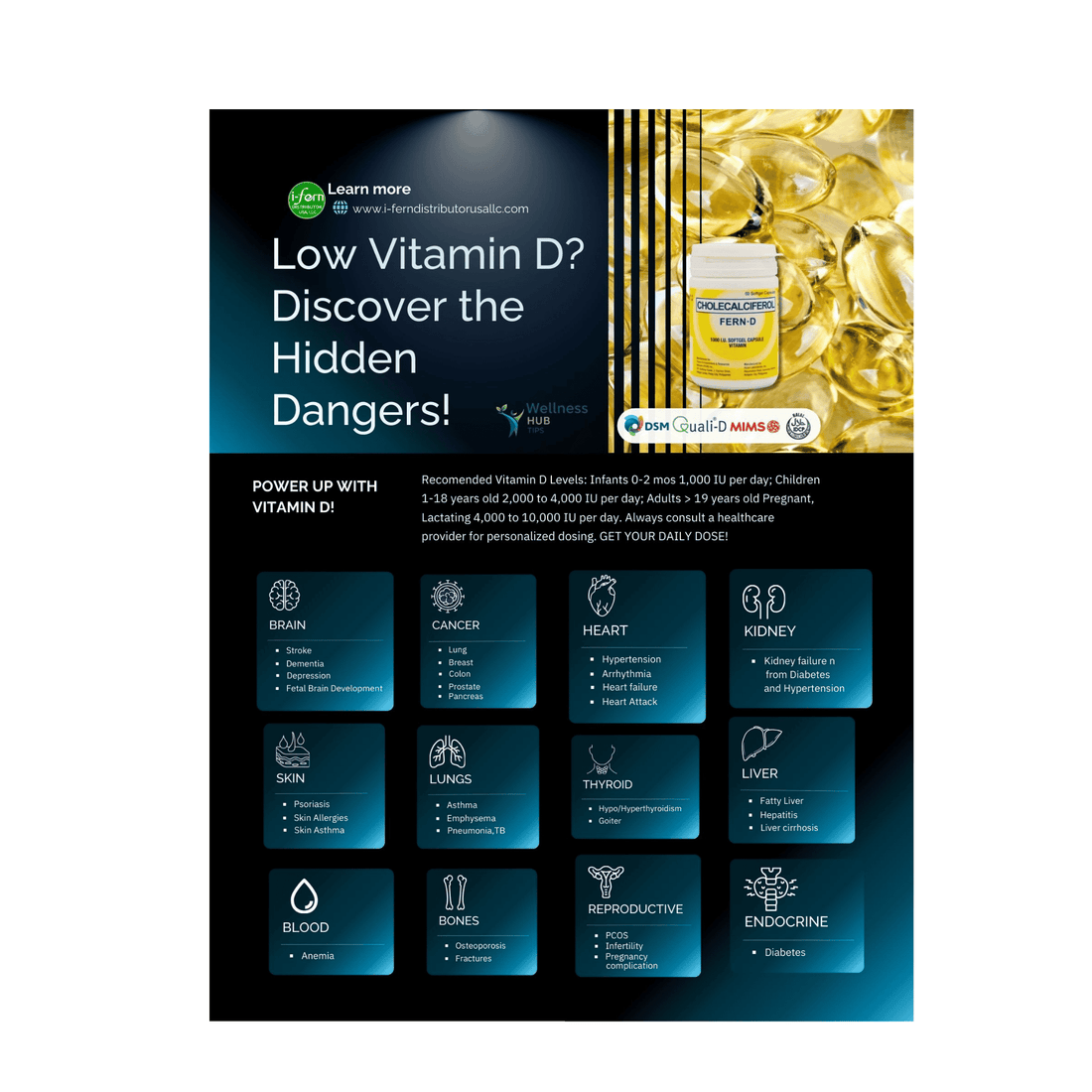
Vitamin D Deficiency: The Silent Threat to Your Health – Risks, Fixes & FERN-D Boost
Share
In a world where we're glued to screens and slathered in sunscreen, Vitamin D deficiency has become an epidemic. But what if that nagging fatigue, unexplained aches, or low mood isn't "just stress"? It could be a sign of low Vitamin D levels quietly fueling bigger risks like cancer, heart disease, and more. At i-Fern Distributor USA LLC, we're passionate about empowering your wellness journey with trusted solutions like FERN-D 1,000 IU Softgels—sourced from DSM Switzerland, MIMS-registered, and halal-certified for purity you can count on.
Whether you're a busy parent, fitness enthusiast, or just curious, these answers will help you spot the signs, understand the stakes, and take charge. (Pro tip: Always consult your healthcare provider before starting supplements—personalized dosing is key!)
1. What Is Vitamin D Deficiency?
Vitamin D deficiency occurs when your body doesn't get enough of this essential "sunshine vitamin," which helps absorb calcium for strong bones, supports immune function, regulates mood, and protects against inflammation. It's super common—affecting up to 40% of adults worldwide—due to limited sun exposure, darker skin tones, obesity, or poor diet. Without enough, your body can't perform at its best, leading to a cascade of health hiccups.
2. What Are the Symptoms of Vitamin D Deficiency?
Many folks fly under the radar with no obvious signs, but watch for these red flags:
- Fatigue & Muscle Weakness: Feeling wiped out despite rest?
- Bone & Back Pain: Achy joints or frequent fractures from weakened density.
- Mood Changes: Depression, anxiety, or "winter blues" that linger.
- Frequent Illnesses: Colds, infections, or slow-healing wounds signal immune dips.
- Hair Loss or Slow Wound Healing: Subtle but telling clues.
If these ring true, a simple blood test (25-hydroxyvitamin D) can confirm levels below 20 ng/mL.
3. What Causes Vitamin D Deficiency?
The culprits? Limited sunlight (hello, office life!), aging skin that produces less Vitamin D, malabsorption issues (like IBS or gastric bypass), vegan/vegetarian diets low in fortified foods, and kidney/liver problems. Even obesity traps Vitamin D in fat cells, making it unavailable. Darker skin needs more sun to synthesize it—up to 3x more!
4. How Much Vitamin D Do I Need Daily?
Guidelines vary by age and life stage (from the NIH and Endocrine Society):
- Infants (0-12 months): 400-1,000 IU
- Children (1-18 years): 600-4,000 IU (aim for 2,000-4,000 for optimal)
- Adults (19+ years): 600-2,000 IU maintenance; up to 4,000-10,000 IU if deficient
- Pregnant/Lactating Women: 4,000-10,000 IU to support baby’s brain & bone development
Start with food (fatty fish, fortified milk, eggs) and sun (10-30 mins midday, arms/legs exposed), then supplement smartly. Our FERN-D 1,000 IU Softgels make it easy—one or more per day, doc-approved.
5. What Happens If I Don't Get Enough Vitamin D? (The Hidden Dangers)
Short-term: Rickets in kids (soft bones) or osteomalacia in adults. Long-term? The risks stack up:
- Brain & Mood: Higher dementia, depression, & cognitive fog risks.
- Heart & Vessels: Hypertension, arrhythmia, heart failure/attack, & stroke.
- Cancers: Elevated odds for lung, colon, breast, pancreas, & prostate.
- Metabolic Mayhem: Diabetes/kidney failure, PCOS, infertility, & pregnancy complications.
- Immune & Respiratory: Asthma, pneumonia, TB, emphysema, & skin issues like psoriasis/allergies.
- Bones & Beyond: Osteoporosis, fractures, anemia, thyroid disorders (hypo/hyperthyroidism, goiter), & liver woes (fatty liver, hepatitis, cirrhosis).
Studies (like those in the Journal of the American Medical Association) show correcting deficiency slashes these risks—it's preventive gold!
6. Who Is at Risk for Vitamin D Deficiency?
High-risk groups include:
- Office workers or northern latitude dwellers (less sun).
- Older adults (reduced absorption/skin production).
- People with obesity, darker skin, or gut disorders.
- Breastfed infants or strict vegans.
- Those with chronic illnesses like diabetes or kidney disease.
Winter months amp it up—yes, you do need more Vitamin D then!
7. How Do I Get More Vitamin D?
- Sun Safely: 15 mins exposure, 3x/week (no sunscreen initially).
- Eat Smart: Salmon, tuna, mushrooms, fortified OJ/cereal.
- Supplement Wisely: Opt for D3 (cholecalciferol) over D2 for better absorption. Try FERN-D for a clean, effective boost—halal, medical-grade, and easy on the tummy.
Ready to Power Up?
Low Vitamin D doesn't have to dim your spark. Test your levels, tweak your routine, and consider FERN-D 1,000 IU Softgels from www.i-ferndistributorusallc.com. Follow our Wellness Hub Tips on Facebook for more hacks!
Disclaimer: This isn't medical advice—chat with your doc for tailored plans. Sources: NIH, Mayo Clinic, Cleveland Clinic.
Share your Vitamin D story in the comments! What's one change you're making today? 👇
